Bitcoin Network vs Bitcoin the Currency
One of the most confusing elements of bitcoin to newcomers is that the term "bitcoin" does encompass two interconnected yet fundamentally distinct elements. These two elements are:
The Bitcoin Network or Payment System: This pertains to the network's underlying code and the collective assembly of nodes that facilitate its operation.
Bitcoin, the Currency or Asset: This is the actual digital currency; bitcoin as the currency or asset you can own.
In order to avoid confusion, the bitcoin network is represented in purple and the bitcoin currency or asset is represented in green from here on.
Bitcoin essentially consists of code, and the bitcoin network comprises a vast array of computers, all running the same software. The code operates as a protocol, establishing the governing rules for the Bitcoin network. This network serves as a payment system, enabling users to send and receive their bitcoin digital currency or asset (BTC).
BITCOIN NETWORK
(THINK OPERATING NETWORK)
BITCOIN CURRENCY
(THINK OWNERSHIP)
Drawing on the existing technology concepts, Bitcoin is an application that has been built on the transformational technology called blockchain. Bitcoin (the application) and blockchain were created in 2009 together when Satoshi Nakamura published the white paper ‘Bitcoin: A Peer-to-Peer Electronic Cash System’. Bitcoin and blockchain came into existence at the same time. They are related but distinct.
Transformational Technology
Bitcoin and blockchain are both “transformational” technologies. A transformational technology is a new technology where there was nothing similar there before it was invented. Most technology advancement is incremental in nature, i.e. it is improvement to or advancement on something that was there before. Truly transformational technologies don't occur very often. Examples include the invention of the steam engine and the World Wide Web (internet). The World Wide Web was invented in the 1970s, and it took until the 1990s for its transformative potential to be recognised and commercialised. The internet, even decades later, continues to grow exponentially each year.
What was transformational about the World Wide Web?
The World Wide Web enabled the efficient sending of “information”. Anyone who is connected to the Internet can send information anywhere in the world in a matter of seconds. The information can be sent directly from one person to another (peer to peer) without the requirement for an intermediary party.
Prior to the internet there were many ways information was transferred. One common method was by written letter, where a centralised Post Office collected and distributed the letters. The internet, combined with the ‘email application’ completely transformed the way we now transfer information. Information can be created and sent to the recipient anywhere in the world without a third party being involved.
Congratulations, you have completed Module 1, Lesson 1


